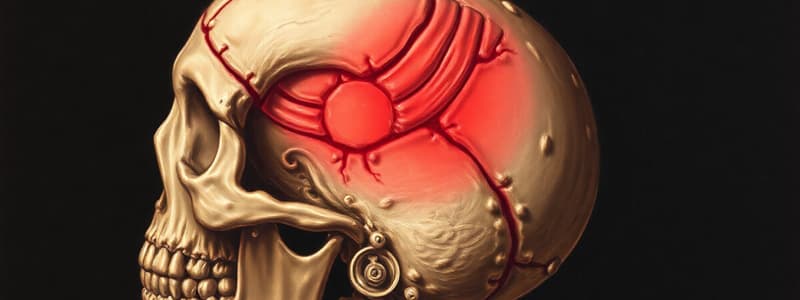Podcast
Questions and Answers
What is a primary indication of impending brain herniation?
What is a primary indication of impending brain herniation?
- Dilated pupils (correct)
- Decreased intracranial pressure
- Regular pulse
- Normal respiratory rate
Which medication is used to draw fluid from the brain into the bloodstream for acute cerebral edema?
Which medication is used to draw fluid from the brain into the bloodstream for acute cerebral edema?
- Furosemide
- Pentobarbital
- Mannitol (correct)
- Phenytoin
Which of the following requires monitoring for electrolyte and fluid status due to its diuretic effect?
Which of the following requires monitoring for electrolyte and fluid status due to its diuretic effect?
- Barbiturate
- Pentobarbital
- Mannitol (correct)
- Phenytoin
What type of respiratory pattern may indicate an increased ICP?
What type of respiratory pattern may indicate an increased ICP?
What is the purpose of maintaining a calm environment for a patient with increased ICP?
What is the purpose of maintaining a calm environment for a patient with increased ICP?
Which of the following actions should be avoided to prevent further increases in ICP?
Which of the following actions should be avoided to prevent further increases in ICP?
What is a common complication of brain herniation related to altered consciousness?
What is a common complication of brain herniation related to altered consciousness?
What is the priority action for a nurse caring for a client who was admitted following a motor vehicle crash and may have a cervical spine injury?
What is the priority action for a nurse caring for a client who was admitted following a motor vehicle crash and may have a cervical spine injury?
During the assessment of a client after surgical evacuation of a subdural hematoma, which assessment should be prioritized?
During the assessment of a client after surgical evacuation of a subdural hematoma, which assessment should be prioritized?
Which findings during an admission assessment indicate increased intracranial pressure (ICP) for a client with a gunshot wound to the head?
Which findings during an admission assessment indicate increased intracranial pressure (ICP) for a client with a gunshot wound to the head?
What is a common adverse effect associated with electrolyte imbalances in patients following trauma?
What is a common adverse effect associated with electrolyte imbalances in patients following trauma?
In monitoring a client with a closed head injury and ICP of 16 mmHg, which of the following actions should be avoided?
In monitoring a client with a closed head injury and ICP of 16 mmHg, which of the following actions should be avoided?
What is a critical reason for keeping a cervical spine immobilized in a client who may have a spinal injury?
What is a critical reason for keeping a cervical spine immobilized in a client who may have a spinal injury?
When assessing for signs of increased ICP, which symptom is least likely to be associated?
When assessing for signs of increased ICP, which symptom is least likely to be associated?
What score indicates a patient is able to obey commands in the Glasgow Coma Scale (GCS) motor response?
What score indicates a patient is able to obey commands in the Glasgow Coma Scale (GCS) motor response?
Which type of skull fracture is most common and typically results from a large impact?
Which type of skull fracture is most common and typically results from a large impact?
What is a common symptom associated with a basilar skull fracture?
What is a common symptom associated with a basilar skull fracture?
Which statement accurately describes a decerebrate posturing response?
Which statement accurately describes a decerebrate posturing response?
What is the most common type of diffuse injury that ultimately leads to brain injury and potentially death?
What is the most common type of diffuse injury that ultimately leads to brain injury and potentially death?
What would be considered a late sign of increased intracranial pressure (IICP)?
What would be considered a late sign of increased intracranial pressure (IICP)?
What action could potentially increase intracranial pressure in a patient with TBI?
What action could potentially increase intracranial pressure in a patient with TBI?
What is the purpose of a craniotomy in the context of traumatic brain injury treatment?
What is the purpose of a craniotomy in the context of traumatic brain injury treatment?
What role does osmotic diuresis play in managing increased ICP?
What role does osmotic diuresis play in managing increased ICP?
Which of the following is not a cause of traumatic brain injury (TBI)?
Which of the following is not a cause of traumatic brain injury (TBI)?
What type of hematoma develops in the space between the dura mater and the skull?
What type of hematoma develops in the space between the dura mater and the skull?
Which mechanism of injury is described as damage caused by the head hitting an object leading to brain rebound effects?
Which mechanism of injury is described as damage caused by the head hitting an object leading to brain rebound effects?
Which of the following symptoms is often associated with mild concussion?
Which of the following symptoms is often associated with mild concussion?
In which scenario is a patient likely to be admitted for observation after experiencing a concussion?
In which scenario is a patient likely to be admitted for observation after experiencing a concussion?
Flashcards
GCS Motor Response
GCS Motor Response
A scale used to assess the level of consciousness and motor function in a patient with a brain injury.
GCS Motor Score 6
GCS Motor Score 6
The patient obeys commands and performs purposeful movements.
GCS Motor Score 5
GCS Motor Score 5
The patient localizes pain with purposeful movement, reaching towards the source of pain.
GCS Motor Score 4
GCS Motor Score 4
Signup and view all the flashcards
GCS Motor Score 3
GCS Motor Score 3
Signup and view all the flashcards
GCS Motor Score 2
GCS Motor Score 2
Signup and view all the flashcards
GCS Motor Score 1
GCS Motor Score 1
Signup and view all the flashcards
Traumatic Brain Injury (TBI)
Traumatic Brain Injury (TBI)
Signup and view all the flashcards
Epidural Hematoma
Epidural Hematoma
Signup and view all the flashcards
Subdural Hematoma
Subdural Hematoma
Signup and view all the flashcards
Intracerebral Hematoma
Intracerebral Hematoma
Signup and view all the flashcards
Intracranial Pressure (ICP)
Intracranial Pressure (ICP)
Signup and view all the flashcards
Cushing's Triad
Cushing's Triad
Signup and view all the flashcards
Skull Fracture
Skull Fracture
Signup and view all the flashcards
Basilar Skull Fracture
Basilar Skull Fracture
Signup and view all the flashcards
Bradycardia
Bradycardia
Signup and view all the flashcards
Increased ICP
Increased ICP
Signup and view all the flashcards
Cheyne-Stokes respirations
Cheyne-Stokes respirations
Signup and view all the flashcards
Herniation
Herniation
Signup and view all the flashcards
Mannitol
Mannitol
Signup and view all the flashcards
Phenytoin
Phenytoin
Signup and view all the flashcards
Hyperventilation
Hyperventilation
Signup and view all the flashcards
Monitor fluid status
Monitor fluid status
Signup and view all the flashcards
Priority after MVC
Priority after MVC
Signup and view all the flashcards
Priority after subdural hematoma
Priority after subdural hematoma
Signup and view all the flashcards
Decreasing ICP in head injury
Decreasing ICP in head injury
Signup and view all the flashcards
Increased ICP signs
Increased ICP signs
Signup and view all the flashcards
GSW Head Injury Assessment Priority
GSW Head Injury Assessment Priority
Signup and view all the flashcards
Increased ICP Danger Sign (Pupil)
Increased ICP Danger Sign (Pupil)
Signup and view all the flashcards
Increased ICP Danger Sign (Pulse)
Increased ICP Danger Sign (Pulse)
Signup and view all the flashcards
Increased ICP Danger Sign(Blood Pressure)
Increased ICP Danger Sign(Blood Pressure)
Signup and view all the flashcards
Study Notes
Impending Brain Herniation
- A primary indication of impending brain herniation is pupillary dilation.
Fluid Management
- Mannitol is frequently used to draw fluid from the brain into the bloodstream for acute cerebral edema.
Diuretic Effects
- Mannitol requires monitoring for electrolyte and fluid status due to its diuretic effect.
Respiratory Patterns
- Cheyne-Stokes respiration, characterized by periods of apnea followed by increasingly deeper breaths, may indicate an increased ICP.
Environmental Considerations
- Maintaining a calm environment for a patient with increased ICP is critical.
ICP Prevention Measures
- Avoid suctioning or coughing, as these actions can further increase ICP.
Brain Herniation Complications
- A common complication of brain herniation related to altered consciousness is coma.
Cervical Spine Injury Management
- The priority action for a nurse caring for a client who was admitted following a motor vehicle crash and may have a cervical spine injury is to maintain cervical spine immobilization.
Subdural Hematoma Assessment
- During the assessment of a client after surgical evacuation of a subdural hematoma, neurological function should be prioritized.
Increased Intracranial Pressure (ICP)
- Findings during an admission assessment indicating increased intracranial pressure (ICP) for a client with a gunshot wound to the head include decreased level of consciousness, headache, vomiting, and pupillary changes.
Electrolyte Imbalance
- Seizures are a common adverse effect associated with electrolyte imbalances in patients following trauma.
ICP Management
- Avoid hyperventilation in a client with a closed head injury and an ICP of 16 mmHg.
Cervical Spine Immobilization
- Keeping a cervical spine immobilized in a client who may have a spinal injury is critical to prevent further damage.
ICP Assessment
- Bradycardia is the least likely symptom associated with increased ICP.
Glasgow Coma Scale (GCS)
- A GCS score of 5 indicates a patient is able to obey commands in the motor response section.
Skull Fracture Classification
- Linear skull fractures are the most common and typically result from a large impact.
Basilar Skull Fracture Symptoms
- Battle's sign (bruising behind the ear) and raccoon eyes (bruising around the eyes) are common symptoms associated with a basilar skull fracture.
Decerebrate Posturing
- Decerebrate posturing is defined as extension of the arms and legs, with the wrists and fingers flexed, in response to pain or external stimuli.
Diffuse Brain Injury
- Diffuse axonal injury is the most common type of diffuse injury that ultimately leads to brain injury and potentially death.
Late Signs of IICP
- Cushing’s triad is a late sign of increased intracranial pressure (IICP) and consists of hypertension, bradycardia, and irregular respirations.
Potential ICP Increase
- Hypertension could potentially increase intracranial pressure in a patient with TBI.
Craniotomy Purpose
- A craniotomy in the context of traumatic brain injury treatment is performed to relieve pressure from bleeding or edema, remove a hematoma, or repair damaged blood vessels.
Osmotic Diuresis
- Osmotic diuresis plays a role in managing increased ICP by drawing fluid from the brain into the bloodstream, thus reducing intracranial pressure.
TBI Causes
- Hypoglycemia is not a cause of traumatic brain injury (TBI).
Epidural Hematoma Location
- An epidural hematoma develops in the space between the dura mater and the skull.
Mechanism of Injury
- Coup-contrecoup injury is described as damage caused by the head hitting an object leading to brain rebound effects.
Mild Concussion Symptoms
- Headache, dizziness, and nausea are often associated with mild concussion.
Concussion Observation Criteria
- A patient who experiences a concussion and has loss of consciousness, neurological impairment, or focal neurological deficits is likely to be admitted for observation.
Studying That Suits You
Use AI to generate personalized quizzes and flashcards to suit your learning preferences.




